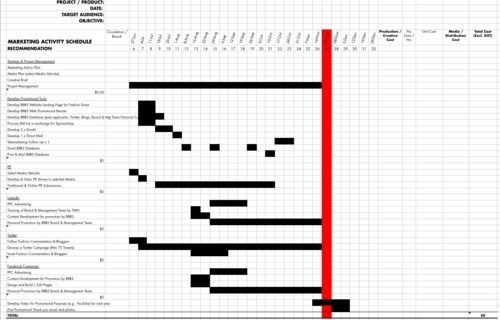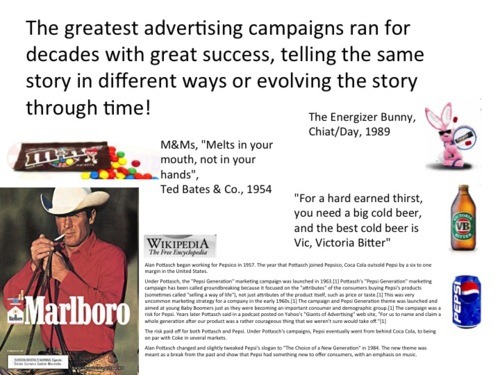by admin | Feb 2, 2012 | Blog, Promotion
The “birth of a brand” is achieved with publicity, not advertising. A new brand must be capable of generating favorable publicity in the media or it will not have a chance in the marketplace. It’s a window into your brand identity.
PR automatically generates greater credibility through “unbiased editorial” rather than a “paid” message.
The ultimate cost effective guerrilla marketing tool, PR can give ‘David’ brand positioning advantages over the larger and better-funded Goliath!
Successful and correctly implemented Public Relations campaign can deliver:
- Greater visibility and exposure than traditional / paid advertising
- Greater frequency levels than traditional / paid advertising
at a fraction of the cost of traditional advertising.

by admin | Jan 31, 2012 | Blog, Strategy
To reach your customers and prospects with your message most cost effectively and improve your Cost Per Lead, you will need the best marketing tool; a plan. Your Marketing Action Plan should include the following:
- Align each target audience with the Appropriate Offer and hence Communication Objective
- Plan each of the target market communications throughout the calendar year.
- Prepare a realistic marketing activity schedule based on the your budget.
- Specify the parties responsible for execution of each initiative.
- Record all of the necessary chronological steps to implement the communication strategies.
The Marketing Activity Schedule usually consists of an excel spreadsheet that outlines each activity, when it occurs and how much it costs to implement. Here is a hypothetical example of what one may look like with costs being omitted.
On the Marketing Activity Schedule you can also mark any important events on your marketing calendar, like trade shows, or product launches, etc.
The one page overview will provide all staff in the company with a great overview of all marketing activities, costs and timings. Together with the Marketing Action Plan, everyone will be on the same page in terms of objectives and responsibilities.

by admin | Jan 30, 2012 | Blog, Promotion, Strategy
Marketing tactics dealing with the importance of frequency is demonstrated below:
1. The first time a man looks at an advertisement, he does not see it.
2. The second time, he does not notice it.
3. The third time, he is conscious of its existence.
4. The fourth time, he faintly remembers having seen it before.
5. The fifth time, he reads it.
6. The sixth time, he turns up his nose at it.
7. The seventh time, he reads it through and says, “Oh brother!”
8. The eighth time, he says, “Here’s that confounded thing again!”
9. The ninth time, he wonders if it amounts to anything.
10. The tenth time, he asks his neighbor if he has tried it.
11. The eleventh time, he wonders how the advertiser makes it pay.
12. The twelfth time, he thinks it must be a good thing.
13. The thirteenth time, he thinks perhaps it might be worth something.
14. The fourteenth time, he remembers wanting such a thing a long time.
15. The fifteenth time, he is tantalized because he cannot afford to buy it.
16. The sixteenth time, he thinks he will buy it some day.
17. The seventeenth time, he makes a memorandum to buy it.
18. The eighteenth time, he swears at his poverty.
19. The nineteenth time, he counts his money carefully.
20. The twentieth time he sees the ad, he buys what it is offering.”
–
Thomas Smith of London wrote this back in 1885 when the Newspaper was the only medium!
Today the estimates are that the average consumer is exposed to between 500 to 5000 brand messages per day. Estimates vary depending who you believe, but regardless of the actual number these figures illustrate that more than ever that ONE exposure is hardly ever enough, especially when it comes to “disruptive” or uninvited media communications.
by admin | Jan 30, 2012 | Blog, Promotion
WHERE ARE YOU SAYING IT?
Where are you communicating with your customers and prospects? Where can you reach them most cost effectively? What are they reading, listening to and watching?
You need to invest wisely and and measure your results by capturing responses to as many of your communication initiatives as possible.
Here are a few rules of thumb for your marketing tactics:
- Budget (Marketing as a rule of thumb is 10% of Sales)
- Media or cost of reaching the customer is about 75% of the Total Marketing Budget
- Reach (most small businesses try to talk with too many prospects / customers)
- Frequency (most small businesses do not repeat their message frequently enough) 100 customer x 10 times is better than 1,000 customers x 1
- Continuity is important (most small businesses do not pursue the dialog for long enough! Rather than appear in 3 editions of the magazine or newspaper with a Full Page advertisement choose to appear in 6 editions with a half page advertisement. The same applies to digital media)
- Media should drive the messageE.g.. Do not make the mistake of producing 5,000 Brochures, first and then ask how will you get them into the hands of your customers and prospects!
- Just because you can get a great deal from the media (of any type) it doesn’t mean it is right for your business. Here are just a few examples of a lack of media planning:
- Why is 2 Office Medical Centre on TV? Especially when there was no point of difference or area of specialty mentioned during the ads.
- Why is a “general brand ad” for a Shopping Center on Radio? Again, as the advertisement on the radio would have reached the entire metropolitan area, this shopping center gave no reason why someone other than those in the immediate geographic catchment would bother getting in their cars and traveling substantial distances.
- Why is a large B2B industrial company on Radio? Have they exhausted all other possibilities? I doubt it. Online Marketing, Social Media, Direct Mail, and the list goes on.
These media choices may have all seemed like great ideas to these small and sometimes large business owners, but that doesn’t make them right. These media choices may have been affordable but were still wrong!
In the 3 examples above each of these businesses has a very specific target market. This specificity is due to either their geographic location or their niche B2B Audience.
Their ‘mass media’ choice will not only produce massive amounts of wastage but is unlikely to deliver the best marketing return on their investment.



Recent Comments